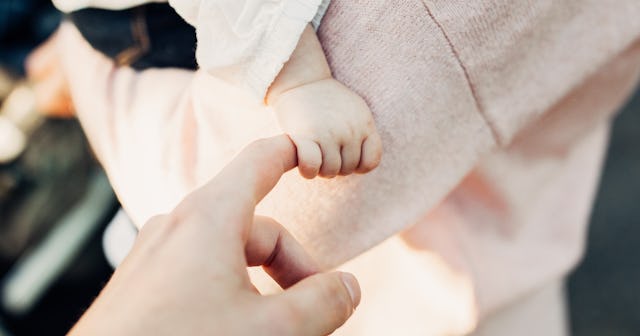What Is the Palmar Grasp Reflex In Infants?

It’s no secret that babies do a lot of cute things — and really, that’s the least they can do to make up for all the crying and diaper bombs. One of their classic moves is holding onto your finger with their tiny hand. Do they even realize how endearing it is? Probably not. And we hate to break it to you, but it’s also not something they’re doing voluntarily. It’s called the palmar grasp reflex, and it’s completely normal in newborn babies. This grasp is one of a group of primitive reflexes, including rooting, sucking, the Moro reflex, tonic neck reflex, and the stepping reflex. Here’s what to know about the palmar grasp reflex.
What is the palmar grasp reflex?
The palmar grasp reflex — also known as the “Darwinian Reflex,” after famous scientist Charles Darwin — is relatively straightforward and happens when stroking the palm of a baby’s hand causes the baby to close their fingers. It typically lasts until the baby is five or six months old. (The toe-version of this reflex — the plantar reflex —usually sticks around until the baby is nine to 12 months old.) At around four months, a baby’s ulnar palmar grasp will kick in, meaning that they’ll be able to hold an object you place in their palm, while gently wrapping one or two fingers (but not the thumb) around it.
And don’t be fooled by the fact that you’re dealing with a baby: Their grip is mighty. Plus, when you try to remove your finger, their grasp will tighten. This is a good thing! When your baby tightly clutches onto your finger, it’s a sign that their nervous system is developing and functioning.
How long does palmar grasp reflex last?
As a baby continues to develop, so does their palmar grasp. Around the eight- to nine-month mark, they’ll move on to the radial palmar grasp, where more precise finger movements are required and utilized. At this point, things will start getting more advanced: The baby will start to pick up objects with their cute little fingertips instead of using their entire hand. Then, when your baby reaches 12 to 15 months, they start to use their palmar supinate grasp. This grasp involves the little one holding an object — like a crayon — in a fist and placing their thumb at the top. Once they can do this, then they can start to “draw” (aka scribble).
How can you test a baby’s palmar grasp reflex?
If you’d like to test out your baby’s palmar grasp reflex (or just trick them into holding your finger), it’s pretty easy to do. Start by laying the baby on a flat surface where they’ll also be comfortable and safe, like a soft mat, a blanket on the floor, or their crib mattress. Then, present both of your pinkies to the baby, and wait for them to take hold. From there, slowly lift their little arms up a few inches and marvel that they’re still holding on. Do keep in mind that when the baby gets tired, they’ll let go of your fingers. When that happens, their arms may flop down suddenly. But don’t worry; it’s completely normal, and your baby will be fine.
Why is the palmar grasp important?
Interestingly, the original purpose of the palmar grasp reflex is unknown. However, experts believe it likely serves to establish a basic motor pattern for organizing bodily movements to voluntarily grab an object. Doctors also find that it can be useful in helping to diagnose certain pathologies. For example, if a child responds to the palmar grasp stimulus with an exaggerated reflex (or, alternately, a weak one), it could signal a neurological issue if it persists past six months of life.
Of course, you should always consult your baby’s pediatrician if you have concerns about their motor or cognitive development.
What comes after the palmar reflex and palmar grasp?
Wondering what your little one’s cute little chubby hands will be mastering next? Around six to seven months old, your baby will develop the radial palmar grasp.
This means they’ll use their thumb while picking up objects from a surface. So, as the index and middle fingers curl around an object, baby’s thumb will start to oppose and press the object into the radial side of their palm. Hence, radial palmar grasp!
This article was originally published on